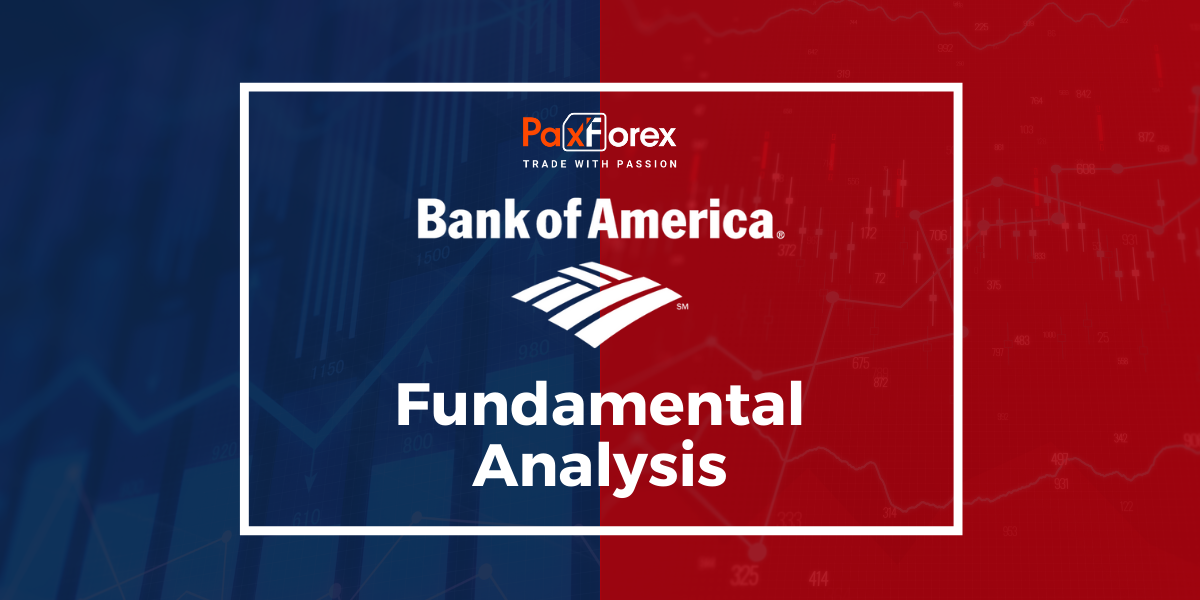
Source: PaxForex Premium Analytics Portal, Fundamental Insight
Initially, Bank of America may appear to be an attractive investment opportunity. Its shares are priced at a modest multiple of less than 10 times this year's projected earnings, and analysts predict similar per-share profits for the following year. Additionally, the 3% dividend yield is quite appealing. Moreover, the bank's bottom line has shown impressive improvement, with a 19% year-over-year increase in the second quarter, thanks to higher interest rates.
However, before rushing into an investment in Bank of America based solely on these valuation measures, it is essential to exercise caution. As the famous investing adage warns us, some stocks are cheap for a reason.
If you currently hold shares in BofA, there is no need to panic. The bank, ranked as the nation's second-largest based on assets, is not facing imminent doom.
Nevertheless, if you are seeking to diversify your portfolio with a banking sector addition, Bank of America might not be the best choice at the moment. Recent developments have raised concerns and cast doubts on the bank's future performance.
One such concern is the bank's recent self-scrutinization of its financial records, which did not align entirely with the Federal Reserve's calculations. Despite passing the "stress test" and subsequently increasing its quarterly dividend payout, Bank of America has initiated discussions with the Federal Reserve to understand discrepancies in Other Comprehensive Income over a 9-quarter stress period between the Federal Reserve's CCAR results and Bank of America's Dodd-Frank Act stress test results.
Additionally, the bank has disclosed a significant disparity in its common equity Tier 1 capital ratio for the second quarter when using the standardized approach compared to a more advanced approach.
This situation could be cause for concern. The world of bank accounting is intricate, involving both quantitative and qualitative aspects.
Of particular note, Bank of America stands out as the sole major banking institution reporting a discrepancy between its own calculations and those of the Federal Reserve, even within its internal assessments. This raises questions about whether there might be other hidden balance sheet issues that went unnoticed during the Dodd-Frank stress test assessment.
The second cause for worry revolves around Bank of America's balance sheet, which hasn't fully recovered from the industrywide liquidity crisis experienced in the first quarter. During this time, SVB Financial's Silicon Valley Bank and First Republic encountered significant liquidity challenges, leading to the former's sale to First Citizens. These events have sparked concerns that all banks may be facing a similar predicament: having limited access to easily marketable shorter-term bonds to cover customer withdrawals, while simultaneously carrying substantial unrealized losses on debt securities not intended for sale before maturity but possibly liquidated if necessary.
The concern about the financial situation wasn't unfounded, and even Bank of America felt the fiscal pressure. However, in hindsight, it appears that most banks were not as severely affected as First Republic and Silicon Valley Bank.
Yet, Bank of America is still facing challenges and not making significant progress against these difficulties. The graphic below highlights the reasons behind this. The bulk of the bank's total assets consists of held-to-maturity assets, which continue to experience a decline in market value despite interest rates stabilizing. In the last quarter, unrealized losses on these investments increased from nearly $100 billion to almost $106 billion, even though the bank reduced its holdings by $10 billion. Some of this decline in value can be attributed to the overall market decline, but some other factors may also be at play. Additionally, the bank's more liquid available-for-sale securities decreased from $166 billion in Q1 to just under $136 billion.
The main issue is that Bank of America is not effectively resolving its liquidity challenge as swiftly or successfully as one would anticipate.
The third concern centers around the bank's equity-based performance ratios, which, despite showing improvement for several quarters, experienced a slight downturn in Q2. Nevertheless, there are positive aspects, as the bank's Q2 bottom line saw a notable improvement of 19%, driven by higher interest rates leading to increased net interest income. Its consumer and corporate banking operations are performing well, compensating for weakness in the wealth management and brokerage areas.
However, when considering these factors collectively, the seemingly minor red flags become more significant. They may indicate that Bank of America is adopting a defensive stance, despite the respectable profit growth in the last quarter. These red flags could also be a result of the bank's vast size and complexity. Regardless, these issues pose a risk to potential investors.
Existing shareholders need not hastily divest their shares. However, if you are contemplating an investment in Bank of America based solely on its valuation, it might be wise to reconsider your plans. At present, the bank appears to be undervalued for specific reasons, and potential investors should be cautious before making any decisions.
As long as the price is above 30.00, follow the recommendations below:
- Time frame: D1
- Recommendation: long position
- Entry point: 31.66
- Take Profit 1: 33.00
- Take Profit 2: 34.50
Alternative scenario:
If the level of 30.00 is broken-down, follow the recommendations below:
- Time frame: D1
- Recommendation: short position
- Entry point: 30.00
- Take Profit 1: 29.00
- Take Profit 2: 28.00













